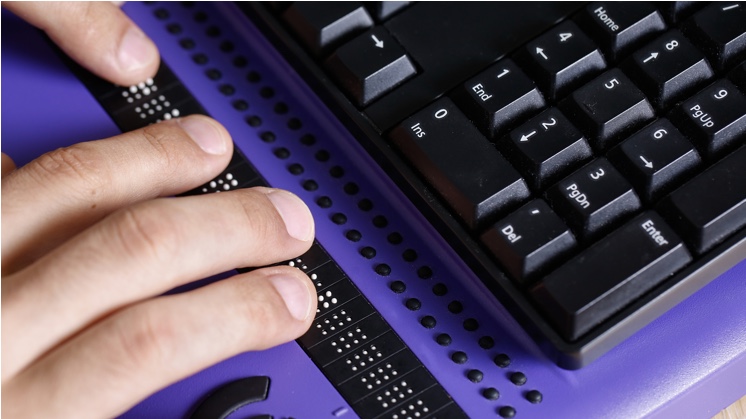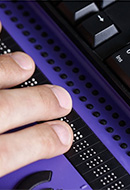Web accessibility
What is web accessibility? The great challenge for achieving an Internet for everyone
There are barriers on the Internet that affect millions of people with disabilities around the world. These days, citizens with motor, sensory and cognitive difficulties are becoming ever-more dependent on advances in web accessibility to enter the mainstream of educational, economic and social development.

We spend an average of six hours and 40 minutes surfing the Internet every day, according to the Digital 2024 report published by We Are Social and Hootsuite. In spite of this, the Internet continues to be out of reach for the vast majority of the world's people with disabilities, according to the international World Wide Web Consortium (W3C) through its Web Accessibility Initiative (WAI).
What is web accessibility?: Importance and benefits of accessible websites
Web accessibility combines programming, design and technology to build a barrier-free Internet that allows all users to understand, learn, navigate and fully interact with the Web. Like industry and architecture that design objects, vehicles and spaces adapted to the needs of people with reduced mobility or cognitive, visual and hearing problems, the Internet must also go down this road.
The global WAI initiative is the driving force behind this work, which ensures that websites and their content fulfil usability and universal accessibility criteria that allow all Internet users to navigate the web regardless of physical, intellectual or sensory limitations. Accessible websites also benefit from other aspects such as more potential visitors, faster loading speeds, improved positioning and online reputation (TrustRank), bandwidth savings, and enhanced compatibility with browsers and devices, etc.
Countries such as Japan, the United States, Canada and Germany are already benchmarks in accessibility, and in the European Union enormous strides have been made in recent years to promote inclusion. In June 2025, the European Accessibility Act (also known as European Directive 2019/882) comes into force, which aims to standardise and harmonise the accessibility requirements of certain public sector companies, large companies and providers of essential services, for example: tech and software development companies, e-commerce, financial services, transport and travel, government bodies, emergency services and social media. This removes digital barriers and ensures that everyone can take part of the digital experience equally.
Its aim is to seek a better functioning European Union (EU) internal market in terms of accessible services but also products. The legislation reflects an EU commitment to equal and fair opportunities for all European citizens. This will also directly benefit businesses that comply with the new regulation, as they increase their reach and customer satisfaction.
Although each member of the EU incorporates and adapts this new regulation to its own country within its internal law, the basis consists of guaranteeing the independence, and social and professional integration of people with disabilities, the elderly, pregnant women or any person with any functional limitations, seeking to ensure equal conditions and opportunities.
Web accessibility recommendations and guidelines (WCAG and others)
The WAI has been issuing standardised, internationally recognised guidelines for creating more accessible content and pages since 1999. These technical recommendations, which are aimed at webmasters, designers and developers, are regularly updated and are grouped into the three blocks summarised below:
W3C and web accessibility levels
The WAI also classifies the web pages according to content accessibility, establishing the following levels:
- Level A: this is the least demanding and includes pages that meet certain conformity criteria determined by the WCAG, such as the availability of subtitles for recorded audio or text alternatives for audiovisual content, etc.
- Level AA: this is the intermediate level and the most usual requirement of bodies that issue web accessibility certifications. It includes websites that fulfil more advanced criteria such as the availability of subtitles for live audio, audio description, adjustable text size, etc.
- Level AAA: this is the strictest level and consists of websites that comply with the most demanding criteria, such as sign language interpretation, extended audio description, explanation of abbreviations, absence of elements that flash more than three times per second, etc
SEE INFOGRAPHIC: WAI* activities to promote web accessibility [PDF]
Tools for checking web accessibility
Some online applications are able to quickly and simply check the degree of accessibility of web pages. This shows which aspects of the website need improvement to make it more accessible according to the WCAG guidelines. Here are some of the most commonly used apps:
- Website Accessibility Versatile Evaluator (WAVE): a suite of accessibility tools that works as a browser extension. It has a free and a paid version.
- axe DevTools: With a version for mobile devices and one for computers, axe DevTools has 2 billion downloads and is the accessibility tool used by eight of the top ten banks in the United States.
- Google Lighthouse: This tool, developed by Google, generates reports on web page faults and explains their importance. It’s also one of the most visual tools for correcting accessibility problems on websites.
- Accessibility Cloud: an online tool that allows automatic and manual monitoring of documents and websites. It’s available in multiple languages and has both free and paid options.
- Siteimprove: an enterprise-level tool, used by the County of Denver (United States), which provides analysis and reports on company websites, as well as solutions to correct errors.
When choosing a web accessibility tool, make sure you consider the needs of the company and that the information provided by the tool is in line with what you are looking for.
The main difference between most of these tools lies in the way they display errors and reports. Axe DevTools, for example, presents bugs with varying degrees of priority, while Google Lighthouse shows them in a more visual way.
As a major advantage, automated tools offer a quick and easy way to improve a product’s accessibility. They can analyse several pages simultaneously very quickly, providing immediate feedback. Efficiency and speed will also depend on whether a free or paid version is used, but in general they make analysis much easier.
Despite these advantages, you have to complement these tools with a manual review, as they should not be relied upon blindly. A study by the UK Government, a benchmark in web accessibility, revealed that these tools only detect 20-30% of accessibility errors on a webpage. With this in mind, the tool might classify something as an error that is not necessarily an error or miss other problems.
Direct feedback or testing with people with various disabilities is essential to make products, services and websites more accessible. This will better adapt the product to the needs of users and customers.

Technology innovation
At Iberdrola, we promote innovation through knowledge of technologies, providing great added value for the businesses.

Diversity and inclusion
Iberdrola has been carrying out strategic actions to ensure diversity and inclusion for its workers, customers and suppliers.

Web accessibility for iberdrola.com
We have certified our Results Presentations and Capital Markets Day web pages according to the Double A standard for accessibility.

What is Plain Language?
Find out, with Iberdrola, all about what plain language is.












